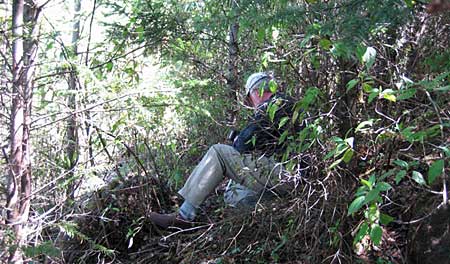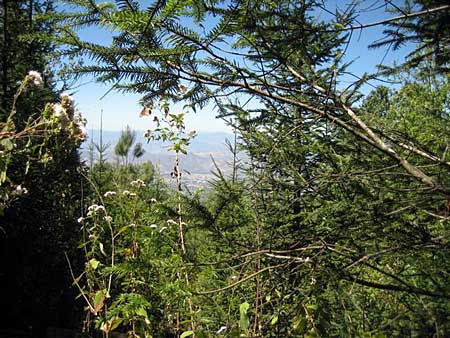New Tree Nursery Near Cerro Pelon
Tuesday, January 29th, 2008 at 7:41 am by Jim LovettFiled under Mexico | 2 Comments »
The monarch colonies in Mexico are scattered over a number of distinct mountains. Among these is Cerro Pelon, a mountain near Zitácuaro that harbors 1-3 relatively small monarch colonies each year. Although it ranks as the third most important monarch overwintering location, there has been a significant loss of forests on this mountain over the last decade due to illegal logging. According to Lincoln Brower, a number of former colony sites on Cerro Pelon have been completely logged over.
Before my trip to Mexico last February I learned of a monarch colony known as Aseradero* on Cerro Pelon that had died out early in the winter. I managed to visit the site in the first week in March. The horseback ride to the site took almost three hours and some parts were rough going. Along the route there were signs of recent deforestation and we passed scenes of destruction of older trees with basal diameters of 3-4 feet. No old growth trees were seen. Most of the backside of the mountain, an area seldom seen by visitors, has been deforested. New growth was evident here and there in the cut over areas but natural regrowth was uneven, perhaps because the loggers removed all or nearly all of the seed trees. The colony site consisted of a relatively sparse stand of 10-15 year old oyamels. The trees offered poor cover on a steep and exposed slope most of which had been clear-cut. Yet, the monarchs had settled there and many of them died, apparently after a cold night or two in January. If there were survivors, they had dispersed long before our visit. Why the monarchs chose this location is not clear, it was a poor choice, but this spot was said to be the site of previous colonies. The dead monarchs formed a carpet covering more than 50% of the forest floor in the small area of the colony that we examined. The butterflies were in remarkably good shape. We took pictures of over 200 monarchs with intact wings for a study of the sizes of the monarchs that reached Mexico and then headed down the mountain.

Chip taking pictures of dead butterflies. Photo by Janis Lentz.

Looking out over the valley from the colony site. Photo by Janis Lentz.
On the ride back I tried to ignore the sounds of chainsaws in the distance and I looked for signs of reforestation. Old plastic plant bags were evident here and there and I spotted some seedlings but most were spindly and overgrown. It is a major task to replant these cut over areas and to protect the seedlings until they become well established.
Protecting the remaining forest on Cerro Pelon and reforesting the logged areas will be challenging. Hopefully, this challenge will be met through the development of a new tree nursery known as “Las Novias del Sol” in the indigenous community of San Juan Xoconusco. This community is located in the municipality of Donato Guerra, 40 kilometers from Zitácuaro. The residents have a long history of resisting illegal logging and now they have a chance to restore much of what has been destroyed over the last decade.
The nursery was inaugurated on 8 December 2007. The goal is to produce a total of 800,000 seedlings per year (oyamels, pines, and cedars) that can be planted at different altitudes and slopes in both the core and buffer zones of the reserve. The nursery will have social and economic benefits. By employing 15 full time workers and 30 others during the planting season, the nursery will contribute to the economic and social fabric of the community. Hopefully, the jobs will reduce emigration to the cities and will lead to community directed sustainable forest management.
The initial cost of the project was 874,000 pesos (US$80,000) of which an alliance of WWFMX-and Telcel, a communications giant in Mexico, contributed 682,000 pesos. An additional 192,000 pesos was provided by the Programa de Coinversión Social de la SEDESOL federal and the Secretaría de Desarrollo Social del Estado de México. The community aided in development of the nursery with manual labor and PROBOSQUE contributed a variety of supplies and seed.
This text was derived from an article published by World Wildlife Fund Mexico in December 2007: “Inaugura Comunidad Indígena del Estado de México vivero forestal ‘Las Novias del Sol’”
*Subsequently measured at .244 hectares (Lincoln Brower, pers. com.).


2 Responses to “New Tree Nursery Near Cerro Pelon”
By Neil Jones on Jan 29, 2008
I wonder if there is some pheromone left by the monarchs from previous seasons which attracts them to the sites. It is odd that colonies form in the same places . I can understand that the environment plays a role but when butterflies chose the wrong place, that used to be a right place it seems there is something other than climatic conditions attracting them at least some of the time
By Joe on Jan 31, 2008
Reading this sad but hopeful story is another reminder that conservation is not just in our backyard but is global. Just think, you can participate in Monarch conservation by creating a monarch waystation in your backyard. While, at the same time people thousands of miles from you are working to reforest their backyard so everybody can enjoy this wonderful butterfly. It’s fun being a citizen of the world.